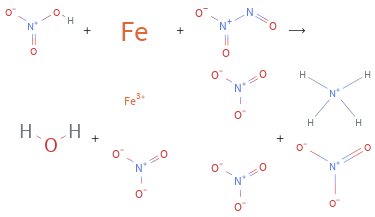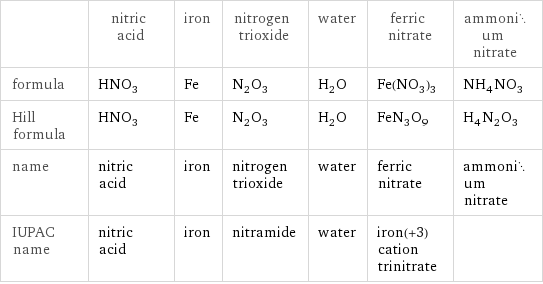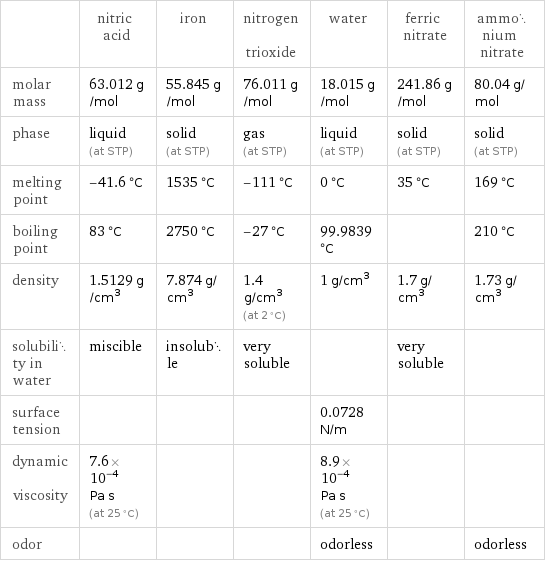Input interpretation

HNO_3 nitric acid + Fe iron + N_2O_3 nitrogen trioxide ⟶ H_2O water + Fe(NO_3)_3 ferric nitrate + NH_4NO_3 ammonium nitrate
Balanced equation

Balance the chemical equation algebraically: HNO_3 + Fe + N_2O_3 ⟶ H_2O + Fe(NO_3)_3 + NH_4NO_3 Add stoichiometric coefficients, c_i, to the reactants and products: c_1 HNO_3 + c_2 Fe + c_3 N_2O_3 ⟶ c_4 H_2O + c_5 Fe(NO_3)_3 + c_6 NH_4NO_3 Set the number of atoms in the reactants equal to the number of atoms in the products for H, N, O and Fe: H: | c_1 = 2 c_4 + 4 c_6 N: | c_1 + 2 c_3 = 3 c_5 + 2 c_6 O: | 3 c_1 + 3 c_3 = c_4 + 9 c_5 + 3 c_6 Fe: | c_2 = c_5 Since the coefficients are relative quantities and underdetermined, choose a coefficient to set arbitrarily. To keep the coefficients small, the arbitrary value is ordinarily one. For instance, set c_3 = 1 and solve the system of equations for the remaining coefficients: c_2 = (4 c_1)/15 + 4/15 c_3 = 1 c_4 = (3 c_1)/10 - 6/5 c_5 = (4 c_1)/15 + 4/15 c_6 = c_1/10 + 3/5 The resulting system of equations is still underdetermined, so an additional coefficient must be set arbitrarily. Set c_1 = 14 and solve for the remaining coefficients: c_1 = 14 c_2 = 4 c_3 = 1 c_4 = 3 c_5 = 4 c_6 = 2 Substitute the coefficients into the chemical reaction to obtain the balanced equation: Answer: | | 14 HNO_3 + 4 Fe + N_2O_3 ⟶ 3 H_2O + 4 Fe(NO_3)_3 + 2 NH_4NO_3
Structures

+ + ⟶ + +
Names

nitric acid + iron + nitrogen trioxide ⟶ water + ferric nitrate + ammonium nitrate
Equilibrium constant
![Construct the equilibrium constant, K, expression for: HNO_3 + Fe + N_2O_3 ⟶ H_2O + Fe(NO_3)_3 + NH_4NO_3 Plan: • Balance the chemical equation. • Determine the stoichiometric numbers. • Assemble the activity expression for each chemical species. • Use the activity expressions to build the equilibrium constant expression. Write the balanced chemical equation: 14 HNO_3 + 4 Fe + N_2O_3 ⟶ 3 H_2O + 4 Fe(NO_3)_3 + 2 NH_4NO_3 Assign stoichiometric numbers, ν_i, using the stoichiometric coefficients, c_i, from the balanced chemical equation in the following manner: ν_i = -c_i for reactants and ν_i = c_i for products: chemical species | c_i | ν_i HNO_3 | 14 | -14 Fe | 4 | -4 N_2O_3 | 1 | -1 H_2O | 3 | 3 Fe(NO_3)_3 | 4 | 4 NH_4NO_3 | 2 | 2 Assemble the activity expressions accounting for the state of matter and ν_i: chemical species | c_i | ν_i | activity expression HNO_3 | 14 | -14 | ([HNO3])^(-14) Fe | 4 | -4 | ([Fe])^(-4) N_2O_3 | 1 | -1 | ([N2O3])^(-1) H_2O | 3 | 3 | ([H2O])^3 Fe(NO_3)_3 | 4 | 4 | ([Fe(NO3)3])^4 NH_4NO_3 | 2 | 2 | ([NH4NO3])^2 The equilibrium constant symbol in the concentration basis is: K_c Mulitply the activity expressions to arrive at the K_c expression: Answer: | | K_c = ([HNO3])^(-14) ([Fe])^(-4) ([N2O3])^(-1) ([H2O])^3 ([Fe(NO3)3])^4 ([NH4NO3])^2 = (([H2O])^3 ([Fe(NO3)3])^4 ([NH4NO3])^2)/(([HNO3])^14 ([Fe])^4 [N2O3])](../image_source/d9c261d21d75de3c53cd7f0230fe7a8d.png)
Construct the equilibrium constant, K, expression for: HNO_3 + Fe + N_2O_3 ⟶ H_2O + Fe(NO_3)_3 + NH_4NO_3 Plan: • Balance the chemical equation. • Determine the stoichiometric numbers. • Assemble the activity expression for each chemical species. • Use the activity expressions to build the equilibrium constant expression. Write the balanced chemical equation: 14 HNO_3 + 4 Fe + N_2O_3 ⟶ 3 H_2O + 4 Fe(NO_3)_3 + 2 NH_4NO_3 Assign stoichiometric numbers, ν_i, using the stoichiometric coefficients, c_i, from the balanced chemical equation in the following manner: ν_i = -c_i for reactants and ν_i = c_i for products: chemical species | c_i | ν_i HNO_3 | 14 | -14 Fe | 4 | -4 N_2O_3 | 1 | -1 H_2O | 3 | 3 Fe(NO_3)_3 | 4 | 4 NH_4NO_3 | 2 | 2 Assemble the activity expressions accounting for the state of matter and ν_i: chemical species | c_i | ν_i | activity expression HNO_3 | 14 | -14 | ([HNO3])^(-14) Fe | 4 | -4 | ([Fe])^(-4) N_2O_3 | 1 | -1 | ([N2O3])^(-1) H_2O | 3 | 3 | ([H2O])^3 Fe(NO_3)_3 | 4 | 4 | ([Fe(NO3)3])^4 NH_4NO_3 | 2 | 2 | ([NH4NO3])^2 The equilibrium constant symbol in the concentration basis is: K_c Mulitply the activity expressions to arrive at the K_c expression: Answer: | | K_c = ([HNO3])^(-14) ([Fe])^(-4) ([N2O3])^(-1) ([H2O])^3 ([Fe(NO3)3])^4 ([NH4NO3])^2 = (([H2O])^3 ([Fe(NO3)3])^4 ([NH4NO3])^2)/(([HNO3])^14 ([Fe])^4 [N2O3])
Rate of reaction
![Construct the rate of reaction expression for: HNO_3 + Fe + N_2O_3 ⟶ H_2O + Fe(NO_3)_3 + NH_4NO_3 Plan: • Balance the chemical equation. • Determine the stoichiometric numbers. • Assemble the rate term for each chemical species. • Write the rate of reaction expression. Write the balanced chemical equation: 14 HNO_3 + 4 Fe + N_2O_3 ⟶ 3 H_2O + 4 Fe(NO_3)_3 + 2 NH_4NO_3 Assign stoichiometric numbers, ν_i, using the stoichiometric coefficients, c_i, from the balanced chemical equation in the following manner: ν_i = -c_i for reactants and ν_i = c_i for products: chemical species | c_i | ν_i HNO_3 | 14 | -14 Fe | 4 | -4 N_2O_3 | 1 | -1 H_2O | 3 | 3 Fe(NO_3)_3 | 4 | 4 NH_4NO_3 | 2 | 2 The rate term for each chemical species, B_i, is 1/ν_i(Δ[B_i])/(Δt) where [B_i] is the amount concentration and t is time: chemical species | c_i | ν_i | rate term HNO_3 | 14 | -14 | -1/14 (Δ[HNO3])/(Δt) Fe | 4 | -4 | -1/4 (Δ[Fe])/(Δt) N_2O_3 | 1 | -1 | -(Δ[N2O3])/(Δt) H_2O | 3 | 3 | 1/3 (Δ[H2O])/(Δt) Fe(NO_3)_3 | 4 | 4 | 1/4 (Δ[Fe(NO3)3])/(Δt) NH_4NO_3 | 2 | 2 | 1/2 (Δ[NH4NO3])/(Δt) (for infinitesimal rate of change, replace Δ with d) Set the rate terms equal to each other to arrive at the rate expression: Answer: | | rate = -1/14 (Δ[HNO3])/(Δt) = -1/4 (Δ[Fe])/(Δt) = -(Δ[N2O3])/(Δt) = 1/3 (Δ[H2O])/(Δt) = 1/4 (Δ[Fe(NO3)3])/(Δt) = 1/2 (Δ[NH4NO3])/(Δt) (assuming constant volume and no accumulation of intermediates or side products)](../image_source/a4a9787fe967206c82c8b0ac760127ce.png)
Construct the rate of reaction expression for: HNO_3 + Fe + N_2O_3 ⟶ H_2O + Fe(NO_3)_3 + NH_4NO_3 Plan: • Balance the chemical equation. • Determine the stoichiometric numbers. • Assemble the rate term for each chemical species. • Write the rate of reaction expression. Write the balanced chemical equation: 14 HNO_3 + 4 Fe + N_2O_3 ⟶ 3 H_2O + 4 Fe(NO_3)_3 + 2 NH_4NO_3 Assign stoichiometric numbers, ν_i, using the stoichiometric coefficients, c_i, from the balanced chemical equation in the following manner: ν_i = -c_i for reactants and ν_i = c_i for products: chemical species | c_i | ν_i HNO_3 | 14 | -14 Fe | 4 | -4 N_2O_3 | 1 | -1 H_2O | 3 | 3 Fe(NO_3)_3 | 4 | 4 NH_4NO_3 | 2 | 2 The rate term for each chemical species, B_i, is 1/ν_i(Δ[B_i])/(Δt) where [B_i] is the amount concentration and t is time: chemical species | c_i | ν_i | rate term HNO_3 | 14 | -14 | -1/14 (Δ[HNO3])/(Δt) Fe | 4 | -4 | -1/4 (Δ[Fe])/(Δt) N_2O_3 | 1 | -1 | -(Δ[N2O3])/(Δt) H_2O | 3 | 3 | 1/3 (Δ[H2O])/(Δt) Fe(NO_3)_3 | 4 | 4 | 1/4 (Δ[Fe(NO3)3])/(Δt) NH_4NO_3 | 2 | 2 | 1/2 (Δ[NH4NO3])/(Δt) (for infinitesimal rate of change, replace Δ with d) Set the rate terms equal to each other to arrive at the rate expression: Answer: | | rate = -1/14 (Δ[HNO3])/(Δt) = -1/4 (Δ[Fe])/(Δt) = -(Δ[N2O3])/(Δt) = 1/3 (Δ[H2O])/(Δt) = 1/4 (Δ[Fe(NO3)3])/(Δt) = 1/2 (Δ[NH4NO3])/(Δt) (assuming constant volume and no accumulation of intermediates or side products)
Chemical names and formulas

| nitric acid | iron | nitrogen trioxide | water | ferric nitrate | ammonium nitrate formula | HNO_3 | Fe | N_2O_3 | H_2O | Fe(NO_3)_3 | NH_4NO_3 Hill formula | HNO_3 | Fe | N_2O_3 | H_2O | FeN_3O_9 | H_4N_2O_3 name | nitric acid | iron | nitrogen trioxide | water | ferric nitrate | ammonium nitrate IUPAC name | nitric acid | iron | nitramide | water | iron(+3) cation trinitrate |
Substance properties

| nitric acid | iron | nitrogen trioxide | water | ferric nitrate | ammonium nitrate molar mass | 63.012 g/mol | 55.845 g/mol | 76.011 g/mol | 18.015 g/mol | 241.86 g/mol | 80.04 g/mol phase | liquid (at STP) | solid (at STP) | gas (at STP) | liquid (at STP) | solid (at STP) | solid (at STP) melting point | -41.6 °C | 1535 °C | -111 °C | 0 °C | 35 °C | 169 °C boiling point | 83 °C | 2750 °C | -27 °C | 99.9839 °C | | 210 °C density | 1.5129 g/cm^3 | 7.874 g/cm^3 | 1.4 g/cm^3 (at 2 °C) | 1 g/cm^3 | 1.7 g/cm^3 | 1.73 g/cm^3 solubility in water | miscible | insoluble | very soluble | | very soluble | surface tension | | | | 0.0728 N/m | | dynamic viscosity | 7.6×10^-4 Pa s (at 25 °C) | | | 8.9×10^-4 Pa s (at 25 °C) | | odor | | | | odorless | | odorless
Units
